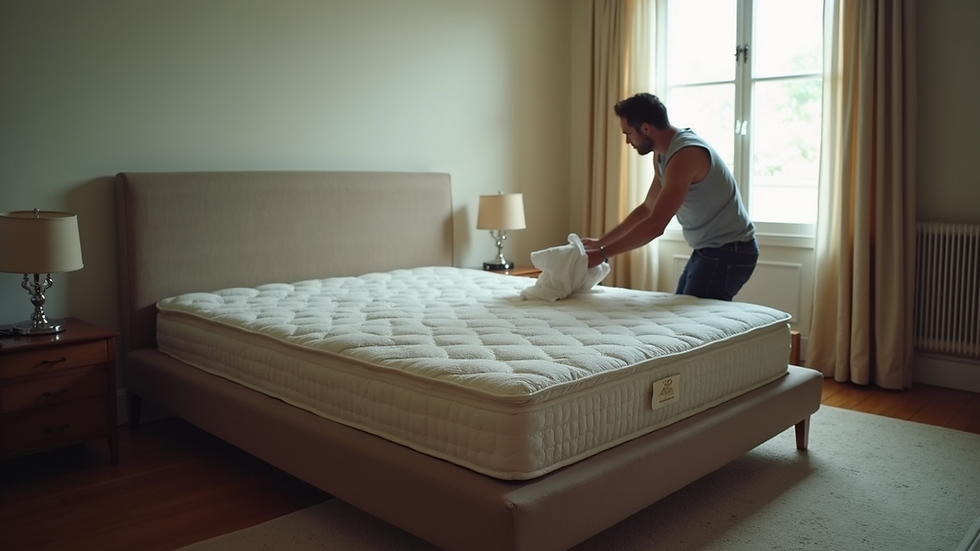Signs It’s Time to Upgrade Your Mattress
- MATCO MATTRESS

- Aug 8
- 4 min read
A good night's sleep is essential for your health and well-being. Your mattress plays a crucial role in how well you rest. Over time, mattresses wear out and lose their support and comfort. Knowing when to upgrade your mattress can help you avoid sleep problems and improve your overall quality of life. This article will guide you through the key signs that indicate it’s time to invest in a new mattress.
How to Know When to Upgrade Mattress Comfort and Support
One of the most obvious signs that you need to upgrade mattress comfort is waking up feeling tired or sore. If you notice stiffness in your back, neck, or joints, your mattress may no longer provide the support your body needs. Mattresses lose their ability to evenly distribute weight and maintain proper spinal alignment as they age.
Look for visible sagging or lumps on the mattress surface. These imperfections can cause pressure points and disrupt your sleep. If you find yourself tossing and turning frequently or waking up in the middle of the night, your mattress might be the culprit.
Tips to improve comfort before upgrading:
Rotate or flip your mattress regularly to extend its life.
Use a mattress topper for added cushioning.
Check your pillows and bedding for wear and replace if needed.
If these steps don’t help, it’s a clear sign that an upgrade is necessary.

Factors That Indicate It’s Time to Upgrade Mattress Quality
Mattress quality deteriorates over time due to daily use and exposure to moisture, dust, and allergens. If you notice an increase in allergy symptoms such as sneezing, congestion, or skin irritation, your mattress may be harboring dust mites or mold.
Another factor is the age of your mattress. Most experts recommend replacing a mattress every 7 to 10 years. However, this depends on the mattress type and how well it has been maintained. High-quality mattresses may last longer, but even the best materials degrade eventually.
If you experience increased discomfort or notice that your mattress no longer feels supportive, it’s wise to consider an upgrade. For more detailed guidance on when to replace mattress, check out this helpful resource.
Signs of declining mattress quality:
Noticeable sagging or indentations.
Increased allergy symptoms.
Worn-out fabric or broken springs.
Unpleasant odors that don’t go away.

When Should You Throw Out a Mattress?
Knowing when to throw out a mattress is important for your health and comfort. If your mattress is over 10 years old, it’s generally time to replace it. However, certain conditions may require earlier replacement.
If your mattress has broken springs, torn fabric, or persistent stains, it’s no longer hygienic or supportive. Also, if you wake up with aches and pains that improve after leaving the bed, your mattress is likely the cause.
Mattresses can also accumulate allergens and bacteria over time, which can affect your respiratory health. If cleaning and airing out the mattress don’t help, it’s best to dispose of it responsibly.
How to dispose of your old mattress:
Check if your city offers mattress recycling programs.
Donate if the mattress is still in good condition.
Use professional disposal services if available.
Replacing your mattress at the right time ensures better sleep and a healthier environment.

How Upgrading Your Mattress Can Improve Sleep Quality
Upgrading your mattress can significantly enhance your sleep quality. A new mattress provides better support, reduces pressure points, and helps maintain proper spinal alignment. This leads to fewer aches and pains and less tossing and turning during the night.
Modern mattresses come with advanced materials like memory foam, latex, and hybrid designs that adapt to your body shape and sleeping style. These materials also improve temperature regulation, keeping you cool and comfortable.
Better sleep quality has many benefits, including:
Increased energy and focus during the day.
Improved mood and reduced stress.
Enhanced immune system function.
Reduced risk of chronic pain and sleep disorders.
Investing in a quality mattress upgrade is an investment in your health and well-being.
Practical Tips for Choosing Your Next Mattress
When it’s time to upgrade your mattress, consider the following tips to make the best choice:
Assess your sleeping position: Side sleepers may prefer softer mattresses, while back and stomach sleepers often need firmer support.
Test different mattress types: Memory foam, innerspring, latex, and hybrid mattresses each have unique benefits.
Check for trial periods and warranties: Many brands offer trial periods so you can test the mattress at home.
Consider your budget: A good mattress is an investment, but there are options available for every price range.
Look for certifications: Certifications like CertiPUR-US ensure the mattress is made without harmful chemicals.
Taking the time to research and test mattresses will help you find the perfect fit for your needs.
Upgrading your mattress is a key step toward better sleep and improved health. By recognizing the signs of wear and understanding your options, you can make an informed decision that benefits you for years to come. Don’t wait until discomfort affects your daily life - start exploring your mattress upgrade options today.





























Comments